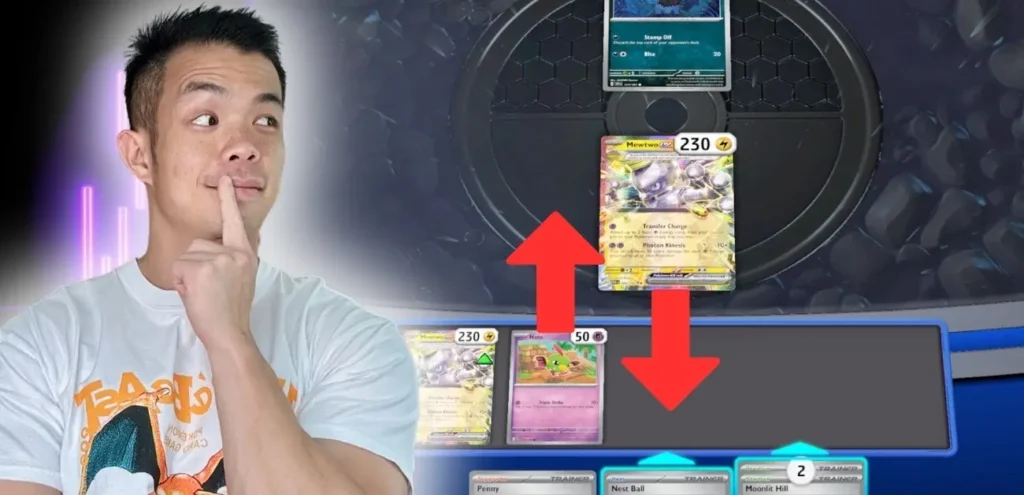A Pokémon TCG retreat lets you swap the Active Pokémon with a Benched Pokémon by discarding Energy equal to its Retreat Cost. It’s a key move to avoid knockouts, heal special conditions, and bring in better attackers. Learn the rules to maintain control over your next battle.
This post may contain affiliate links. See our affiliate policy for more information.
Most Pokémon card players are obsessed with attacks and taking Prize cards. Fair enough- that’s how you win. But sometimes the smartest move is…backing off.
Knowing when and how to retreat your Active Pokémon can change the direction of a match entirely.
In this guide, we’re breaking down everything you need to know about retreating in Pokémon TCG- why it matters, how it works, and what that retreat cost means.
Key Takeaways
- Strategic retreating is a skill that can help you win more battles.
- A manual retreat costs Energy and can only happen once per turn.
- Pokémon have different retreat costs.
- Switch effects from Trainer cards and Abilities do not count as a manual retreat.
- Special conditions and card effects are removed when Pokémon retreat.
When To Retreat Pokémon TCG
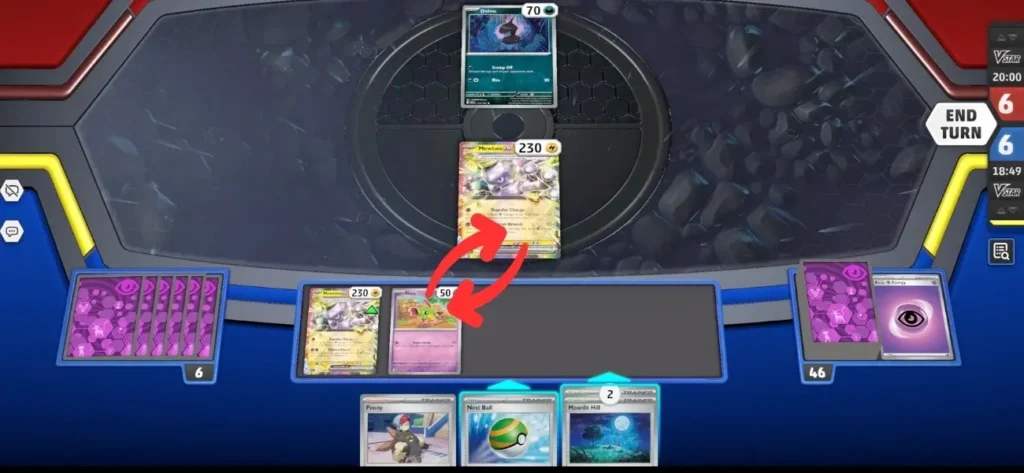
Knowing when to retreat is a core skill when playing the Pokémon card game. It isn’t about running away. It’s about stepping back with intention to keep your Pokémon safe.
The main reasons to retreat in Pokémon cards:
1. Save a Pokémon from a KO
Is your Active Pokémon clinging to life with 10 HP? Don’t just hand your opponent an easy KO. Pull it back. Keep it in play. Maybe bring it back later when the timing’s right.
2. Bring in a Better Attacker
Not every matchup favors your Active. Maybe it’s weak to the opponent’s type or just isn’t hitting hard enough. Retreat it and tag in a Pokémon that can actually make a difference.
3. Heal Special Conditions
Active Pokémon Poisoned, Burned, or Confused? Retreating wipes away status effects as soon as your Pokémon hits the Bench. Just remember: if it’s Asleep or Paralyzed, you’re stuck until you remove the condition or use a switch effect.
4. Pivoting Into A Counterattack
Got a Pokémon with free or low retreat in play? Use it as a temporary shield. It can soak up a hit or two while you set up a better attacker, then pivot out when you’re ready to strike back.
Now you understand why retreating is an essential skill. Let’s dive into how to retreat a Pokémon…without breaking the rules.
Manual Retreating Vs Switching A Pokémon
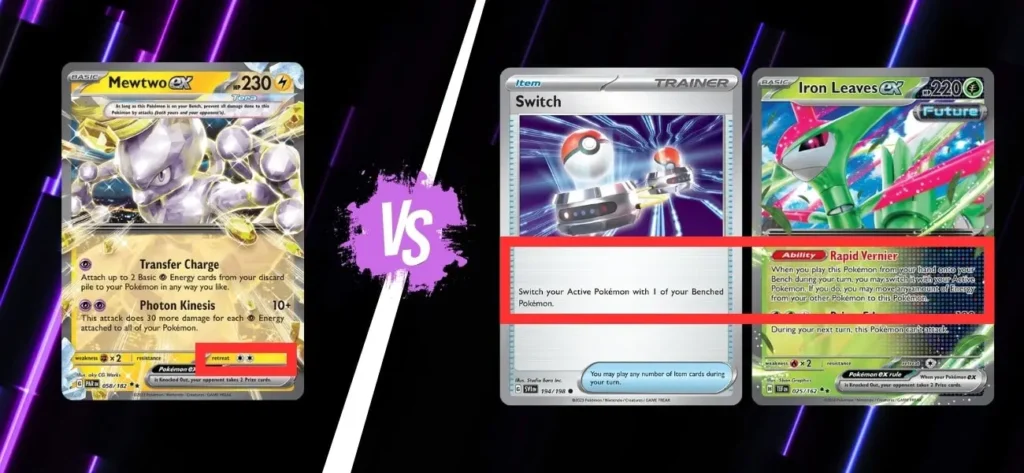
Before we explain how to retreat a Pokémon card, we need to define the differences between a “manual retreat” and a “switch”.
A manual retreat is the default way of retreating. You pay the retreat cost of your Active Pokémon during your turn and switch it with one from your Bench. This can be done once per turn.
A “switch” is different because it’s a card effect. You use a Trainer card like Switch (SVI 194) or an Ability like Rapid Vernier by Iron Leaves ex (TEF 025) to swap your Active Pokémon without paying Energy. This can be done as many times as you like as long as you have access to the card and you follow the rules in the card description.
Importantly, you can manually retreat and activate a switch effect on the same turn.
How A Pokémon TCG Retreat Works
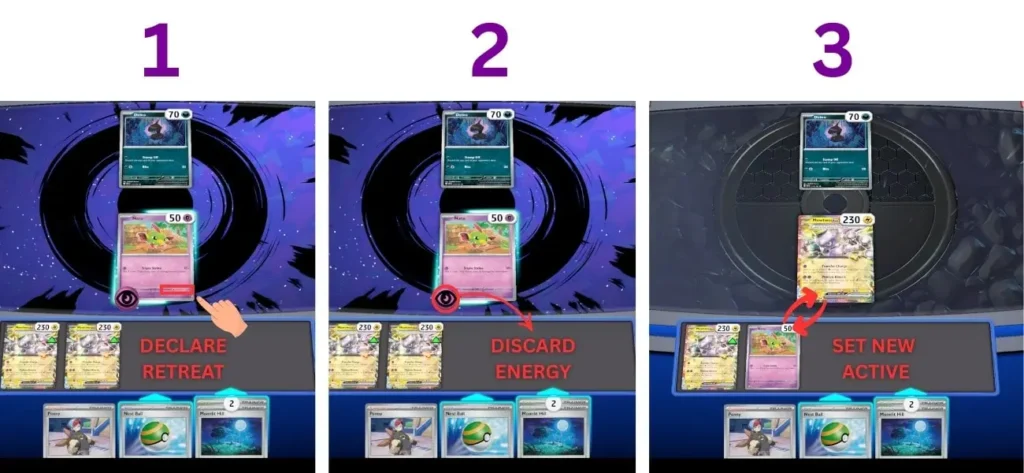
Here’s how to manually retreat a Pokémon card:
- Declare your retreat. Your opponent needs to know!
- Pay the retreat cost. Look at the Retreat Cost of your Active Pokémon. Discard that many Energy cards from the Active Pokémon- any type will do.
- Switch it out. Choose a Pokémon from your Bench to replace it. The former Active goes to the Bench, keeping any damage and any remaining attached cards that were not discarded to pay the Retreat Cost.
Manual retreating is done during your main phase and before your attack phase.
The Retreat Cost
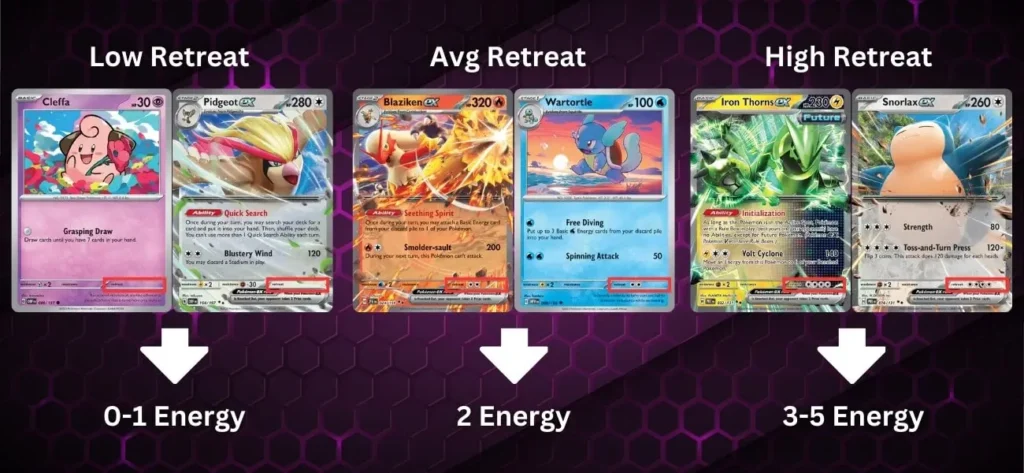
Every Pokémon card has a retreat cost shown as Colorless ☆ symbols at the bottom of the card, indicating the number of energy it needs to discard to retreat.
The higher the cost, the more Energy you need to discard.
Don’t see a retreat cost? That’s called a “zero” or “free” retreat. In other words, the Pokémon can retreat without discarding any Energy.
Pokémon cards can be categorised by their Retreat Cost as follows:
| Classification | Typical Retreat Cost | Charecteristics | Example Pokémon |
|---|---|---|---|
| Low Retreat | 0 to 1 Energy | Mobile, quick to move, and great pivots. | Nimble speedsters like Cleffa (OBF 080), Pikachu ex (SSP 057), and Pidgeot ex (OBF 164). |
| Average Retreat | 2 Energy | Manageable but not cheap to retreat. Retreating often needs preparation in advance. | Most Stage 1 and 2 evolutions and Pokémon V/VSTAR/ex. |
| High Retreat | 3 to 5 Energy | High HP and able to sustain lots of damage but difficult to retreat. | Bulky tanks like Iron Thorns ex (PRE 032) and Snorlax ex (PRE 076). |
Pro tip: Ready to level up at PTCG and win more battles? Make it easier to retreat your Pokémon and harder for your opponent to retreat theirs with these cards that change retreat cost.
8 Essential Pokémon TCG Retreat Rules
A summary of mandatory Retreat rules you need to know to play Pokémon cards properly:
1. One Manual Retreat Per Turn
You get one manual retreat per turn. That’s it. You can’t pay Energy and keep swapping your Active Pokémon in and out like a revolving door. Once you’ve retreated, you’re locked in- unless you use a switch effect. So plan wisely.
2. Discard Energy To Pay Retreat Cost
If your Active Pokémon has a retreat cost of 2, you’ll need to discard 2 Energy from it to make the switch. Doesn’t matter what type- retreat cost is always paid in Colorless Energy (black star white background), so any Energy will do. If the Pokémon doesn’t have enough attached? You’re stuck.
3. One Special Energy Can Cover A Multi-Energy Retreat Cost
Special Energy cards that provide multiple energies at once can cover any Retreat Cost up to the amount of energy it’s actively providing.
For example, Reversal Energy (PAL 192) provides 3x Energy if you have more Prize cards remaining than your opponent. This means it can be used to pay a 1 Energy, 2 Energy, or 3 Energy Retreat Cost (as long as it’s effect is active).
4. Asleep or Paralyzed Pokémon Cannot Retreat
If your Active Pokémon is Asleep or Paralyzed, you can’t retreat it manually. It’s stuck. But a Trainer card like Switch or Escape Rope can still get it out of the Active Spot without needing to retreat.
5. Retreating Resets Special Conditions & Effects
Special Conditions like Poison, Burn, and Confusion disappear the moment a Pokémon retreats to the Bench. Retreating also clears lingering card effects like “this Pokémon can’t attack next turn”.
6. You Can Retreat & Switch On The Same Turn
Is your Active Pokémon stuck with a “cannot attack during next turn” effect applied? Manually retreat and then use a switch card to bring it back into the Active Spot. Now you can attack because retreating clears all card effects (see rule 6). Skilled players use this rule to create combos to get out of sticky situations.
7. You Must Have a Bench
It might sound obvious, but no Bench, no retreat. If your Active Pokémon is flying solo, there’s no one to switch with. You’ll need to play a Basic from your hand to rebuild your Bench- so always manage your bench well to keep your retreat options open.
8. You Cannot Retreat After Attacking
Attacking ends your turn- that’s just how turns work in Pokémon cards. So you can’t attack and then retreat. Retreating doesn’t end your turn, but attacking absolutely does.
Conclusion
The Pokémon TCG Retreat is less of a way out and more of a way forward. When you understand how and when to retreat properly and manage retreat costs, you gain control over your opponent.
Stay mobile. Stay strategic. Retreat with intent.
FAQ
Kalam is a PTCG gameplay expert and content creator. He started playing and collecting Pokémon cards since 1996. When he’s not working, you can find him nerding out on Anime!
Ready To Master PTCG?

